外研版(2019)必修 第二册Unit 5 On the road Using language公开课课件(共38张PPT)
文档属性
| 名称 | 外研版(2019)必修 第二册Unit 5 On the road Using language公开课课件(共38张PPT) | 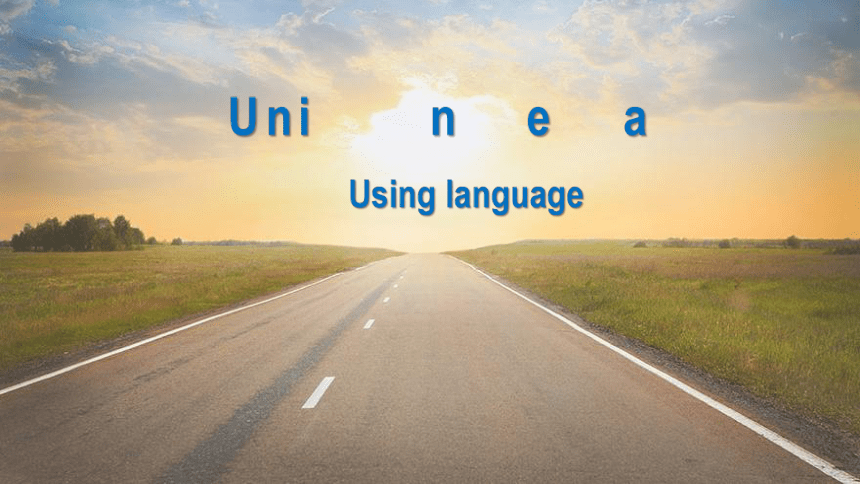 | |
| 格式 | pptx | ||
| 文件大小 | 1.2MB | ||
| 资源类型 | 教案 | ||
| 版本资源 | 外研版(2019) | ||
| 科目 | 英语 | ||
| 更新时间 | 2023-02-27 18:16:47 | ||
图片预览

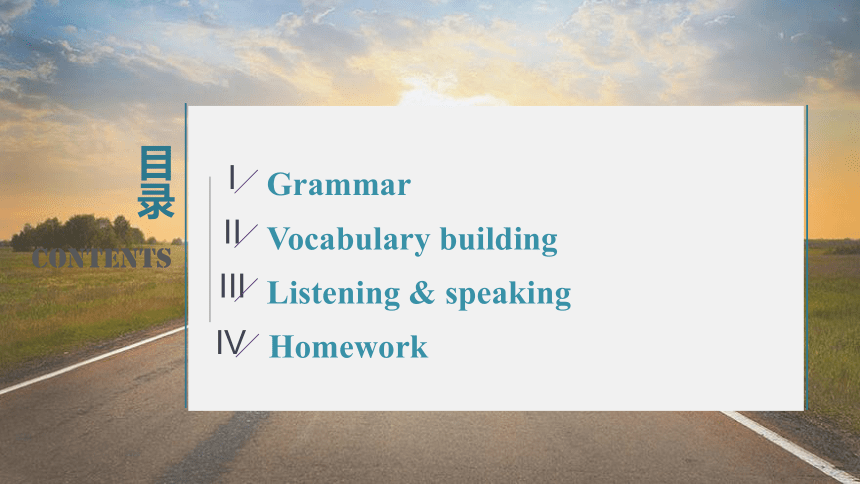
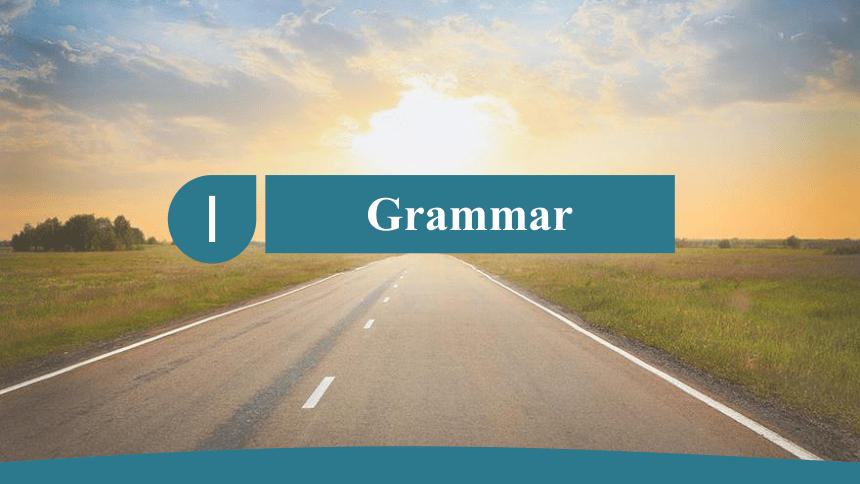
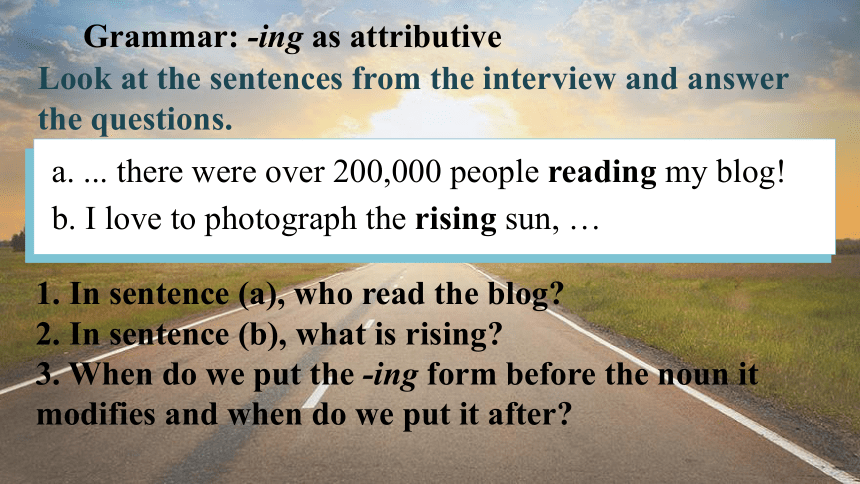
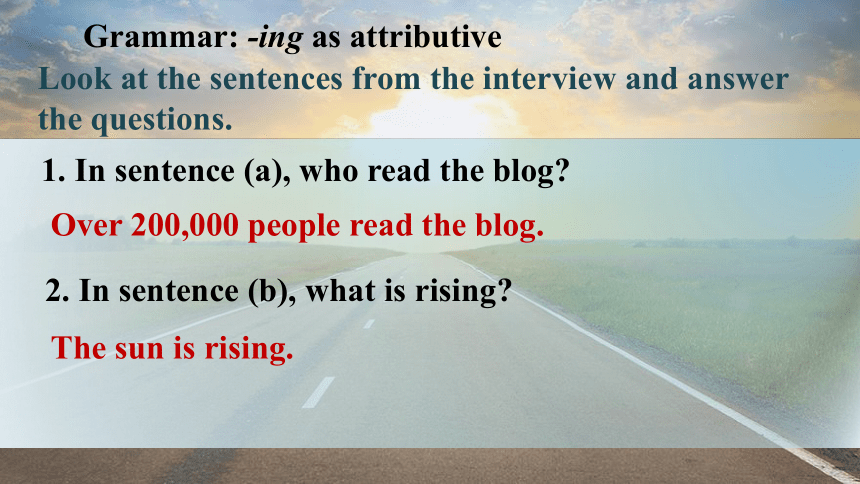
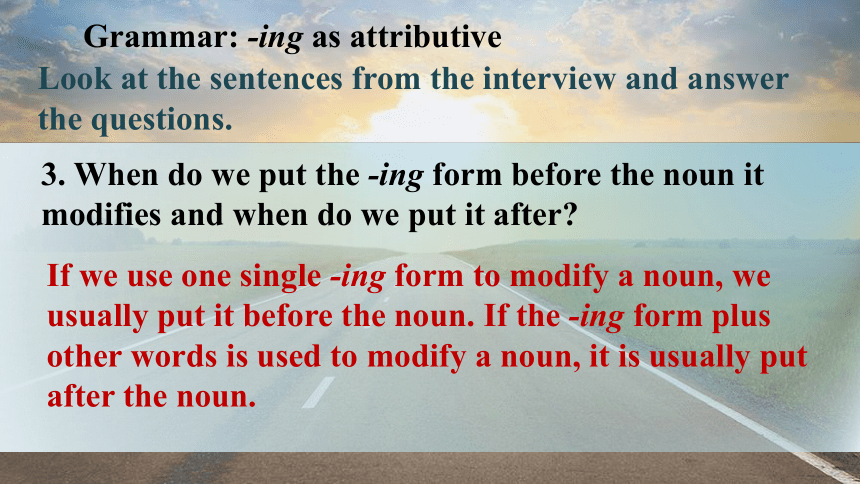
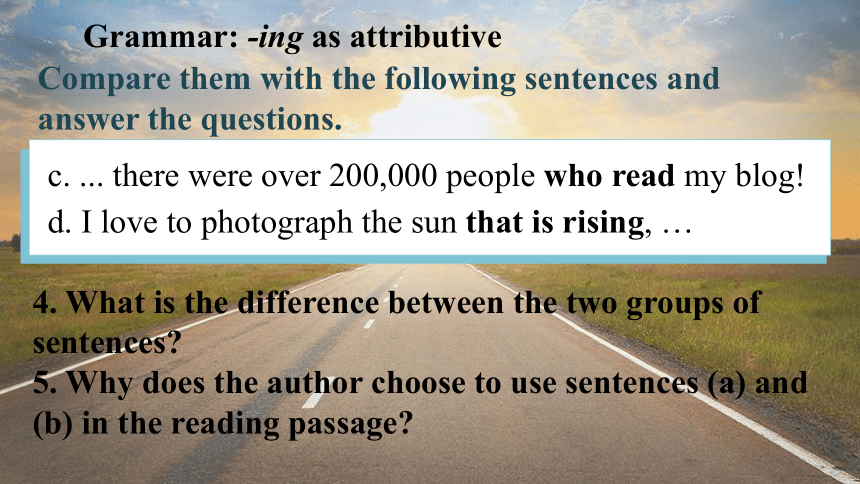
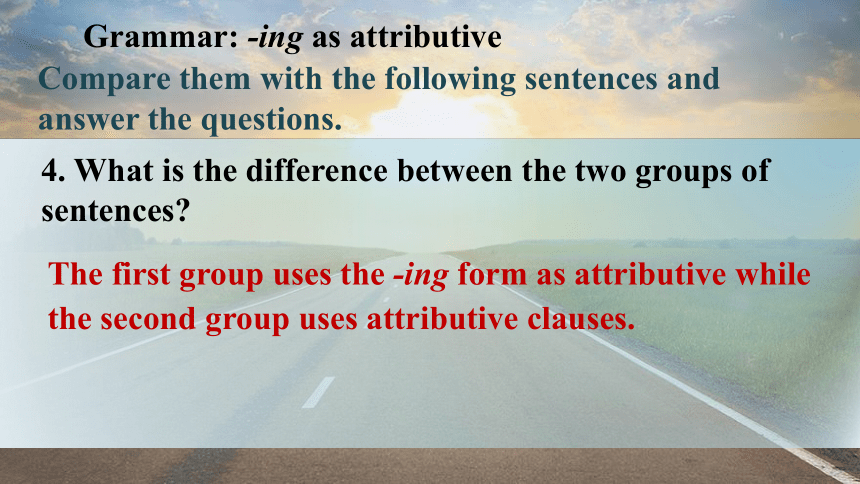
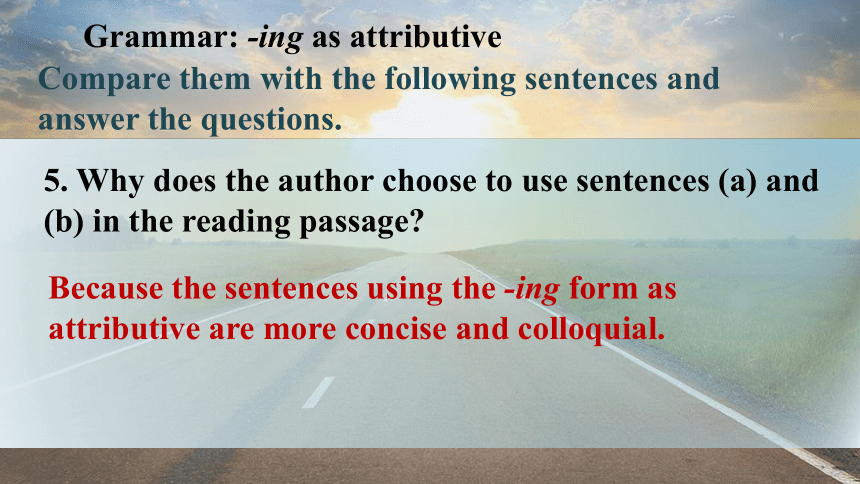
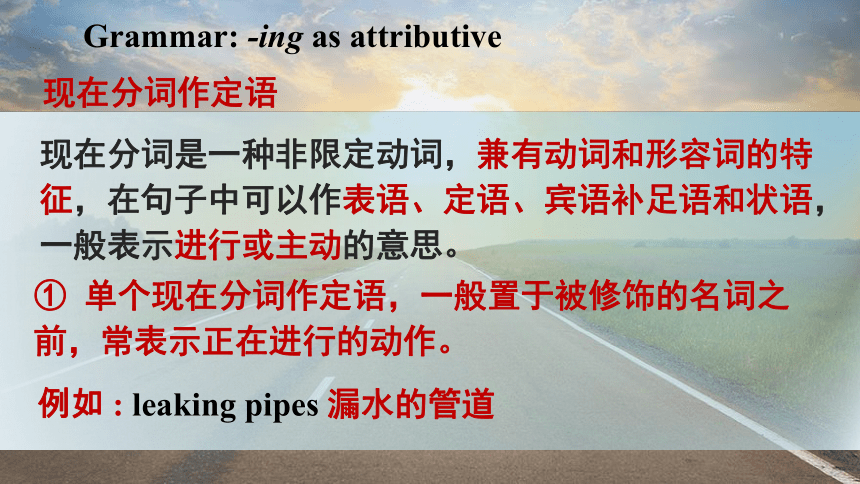
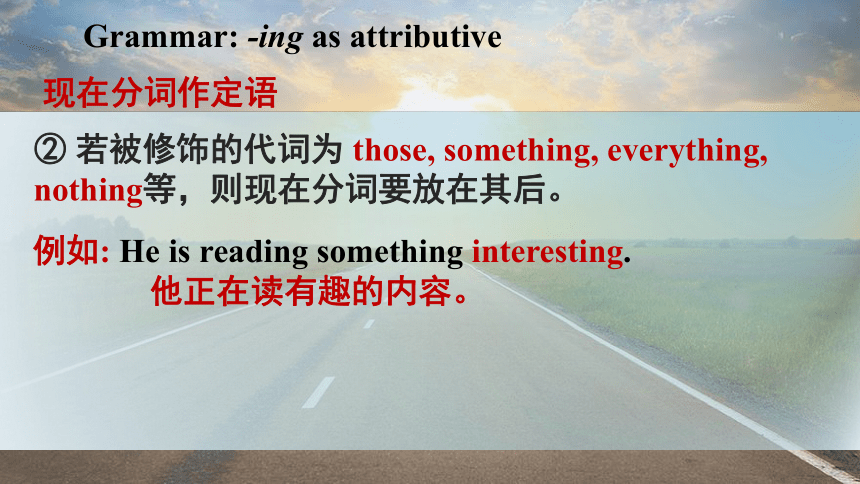
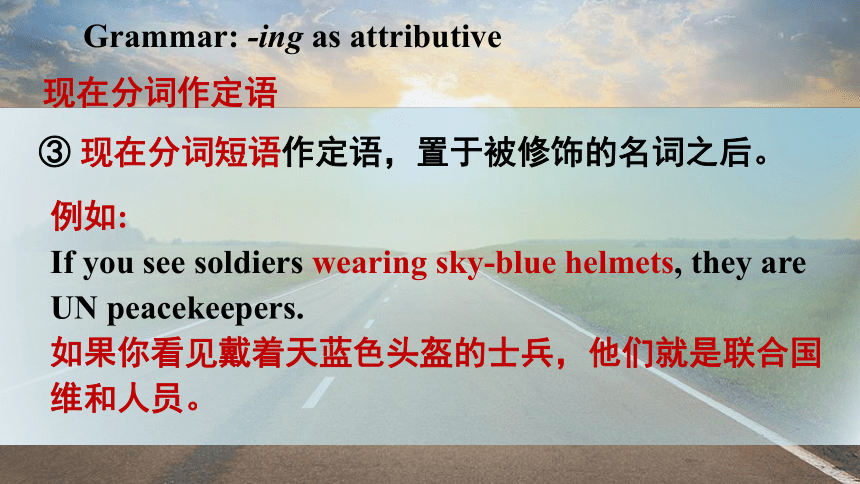
文档简介
(共38张PPT)
Using language
Unit 5 On the road
目录
contents
Grammar
I
IV
Vocabulary building
II
Listening & speaking
III
Homework
I
Grammar
Grammar: -ing as attributive
Look at the sentences from the interview and answer the questions.
0,000 people reading my blog! b I love to photograph the rising sun, …
a. ... there were over 200,000 people reading my blog!
b. I love to photograph the rising sun, …
1. In sentence (a), who read the blog
2. In sentence (b), what is rising
3. When do we put the -ing form before the noun it modifies and when do we put it after
Grammar: -ing as attributive
Look at the sentences from the interview and answer the questions.
Over 200,000 people read the blog.
1. In sentence (a), who read the blog
2. In sentence (b), what is rising
The sun is rising.
Grammar: -ing as attributive
Look at the sentences from the interview and answer the questions.
If we use one single -ing form to modify a noun, we usually put it before the noun. If the -ing form plus other words is used to modify a noun, it is usually put after the noun.
3. When do we put the -ing form before the noun it modifies and when do we put it after
Grammar: -ing as attributive
Compare them with the following sentences and answer the questions.
0,000 people reading my blog! b I love to photograph the rising sun, …
c. ... there were over 200,000 people who read my blog! d. I love to photograph the sun that is rising, …
4. What is the difference between the two groups of sentences
5. Why does the author choose to use sentences (a) and (b) in the reading passage
Grammar: -ing as attributive
Compare them with the following sentences and answer the questions.
4. What is the difference between the two groups of sentences
The first group uses the -ing form as attributive while the second group uses attributive clauses.
Grammar: -ing as attributive
Compare them with the following sentences and answer the questions.
5. Why does the author choose to use sentences (a) and (b) in the reading passage
Because the sentences using the -ing form as attributive are more concise and colloquial.
Grammar: -ing as attributive
现在分词是一种非限定动词,兼有动词和形容词的特征,在句子中可以作表语、定语、宾语补足语和状语, 一般表示进行或主动的意思。
现在分词作定语
① 单个现在分词作定语,一般置于被修饰的名词之前,常表示正在进行的动作。
例如 : leaking pipes 漏水的管道
Grammar: -ing as attributive
现在分词作定语
② 若被修饰的代词为 those, something, everything, nothing等,则现在分词要放在其后。
例如: He is reading something interesting.
他正在读有趣的内容。
Grammar: -ing as attributive
现在分词作定语
③ 现在分词短语作定语,置于被修饰的名词之后。
例如:
If you see soldiers wearing sky-blue helmets, they are UN peacekeepers.
如果你看见戴着天蓝色头盔的士兵,他们就是联合国维和人员。
Grammar: -ing as attributive
现在分词作定语
④ 当现在分词或现在分词短语位于被修饰的名词之后时,往往可用定语从句替代。
例如:
Peter received a letter saying his grandma would come to see him soon.
= Peter received a letter which / that said his grandma would come to see him soon.
Peter 收到一封信,信里说他祖母很快要来看他。
Grammar: -ing as attributive
Rewrite the underlined words using the -ing form.
Grammar: -ing as attributive
The Bernina Express follows a route running from Eastern Switzerland to Northern Italy. People travelling aboard the Bernina Express have the chance to see incredible views. The landscape lining the route is beautiful and dramatic, with snowy mountains and green valleys.
Grammar: -ing as attributive
There is no doubt that the Bernina Express is a journey for travellers wanting to get back to nature: the train window becomes the TV screen, and the natural world is the show.
Grammar: -ing as attributive
Rewrite the advertisement using the -ing form to make it more compact and coherent.
Are you one of those people who work around the clock Are you getting “itchy feet” Take a look at our new offer: a once-in-a-lifetime adventure to the beautiful islands of Hawaii!
Go on a boat trip to see whales that jump out of the water and hear the song of dolphins that sing. Watch surfers who catch the waves — and maybe even give it a go yourself!
Grammar: -ing as attributive
Rewrite the advertisement using the -ing form to make it more compact and coherent.
Put on your hiking boots and explore islands with waterfalls and active volcanoes. And at the end of the day, you won’t want to miss the view of the sun that is setting on the sea!
Grammar: -ing as attributive
Rewrite the advertisement using the -ing form to make it more compact and coherent.
Are you one of those people working around the clock Are you getting “itchy feet” Take a look at our new offer: a once-in-a-lifetime adventure to the beautiful islands of Hawaii!
Go on a boat trip to see whales jumping out of the water and hear the song of singing dolphins. Watch surfers catching the waves — and maybe even give it a go yourself!
Grammar: -ing as attributive
Rewrite the advertisement using the -ing form to make it more compact and coherent.
Put on your hiking boots and explore islands with waterfalls and active volcanoes. And at the end of the day, you won’t want to miss the view of the sun setting on the sea!
II
Vocabulary building
Vocabulary building: Planning a trip
Read the emails. Underline the tasks Andrew and Matt have to do before going on a trip.
Vocabulary building: Planning a trip
Read the emails. Underline the tasks Andrew and Matt have to do before going on a trip.
Vocabulary building: Planning a trip
Complete the chart with the tasks in the above Activity.
1 _____________________
do research
Choose a destination
make a budget
Vocabulary building: Planning a trip
Complete the chart with the tasks in the above Activity.
book flights or other transport
2 ________________________
arrange transfer to hotel
check if you need to
3 ________________________
exchange foreign currency if necessary
Make travel arrangements
book accommodation
apply for a visa
Vocabulary building: Planning a trip
Complete the chart with the tasks in the above Activity.
4 _____________________
check the weather
5 _____________________
print boarding pass or collect tickets in advance
Get ready to go
check in online
pack luggage
Vocabulary building: Planning a trip
Work in groups. Choose a destination and prepare your trip together.
Useful expressions:
Our group will go to … First, we’ll …
Then, we’ll check if …
We also need to …
Before departing, we should …
III
Listening & speaking
Listening & speaking: Before listening
Did You Know
Different types of tourism:
Food tourism: travellers choose their
destination for its food.
Cultural tourism: travellers go to
theatres, museums and festivals to
learn about local art, history and
lifestyle.
Listening & speaking: Before listening
Did You Know
Different types of tourism:
Adventure tourism: travellers
explore unusual or remote
destinations, often engaging in risky
activities.
Listening & speaking: While-listening
Listen to the conversation and find out where it takes place.
Answer: C
Listening & speaking: While-listening
1 History Museum
behind 1 ________________
opens at 2 _______________
___________
Listen again and complete the map and the information for the tourist.
the town hall
half past nine in
the morning
Listening & speaking: While-listening
2 Paul’s Restaurant
next to 3 ___________________
serves 4 _____________________
Listen again and complete the map and the information for the tourist.
the post office
delicious fish and chips
Listening & speaking: While-listening
3 boat race
between 5 _______________ and 6 __________ universities
starts 7 __________________
Listen again and complete the map and the information for the tourist.
Oxford
Cambridge
tomorrow afternoon
Listening & speaking: While-listening
Now talk about how the speakers ask for and give information. Listen again if necessary.
Listening & speaking: Pair work
Work in pairs. Act out asking for and giving information. Student A: Turn to Page 83.
Student B: Turn to Page 86.
IV
Homework
Homework
1. Summarize the usage of -ing as attributive;
2. Draw your own map and have a similar conversation.
Using language
Unit 5 On the road
目录
contents
Grammar
I
IV
Vocabulary building
II
Listening & speaking
III
Homework
I
Grammar
Grammar: -ing as attributive
Look at the sentences from the interview and answer the questions.
0,000 people reading my blog! b I love to photograph the rising sun, …
a. ... there were over 200,000 people reading my blog!
b. I love to photograph the rising sun, …
1. In sentence (a), who read the blog
2. In sentence (b), what is rising
3. When do we put the -ing form before the noun it modifies and when do we put it after
Grammar: -ing as attributive
Look at the sentences from the interview and answer the questions.
Over 200,000 people read the blog.
1. In sentence (a), who read the blog
2. In sentence (b), what is rising
The sun is rising.
Grammar: -ing as attributive
Look at the sentences from the interview and answer the questions.
If we use one single -ing form to modify a noun, we usually put it before the noun. If the -ing form plus other words is used to modify a noun, it is usually put after the noun.
3. When do we put the -ing form before the noun it modifies and when do we put it after
Grammar: -ing as attributive
Compare them with the following sentences and answer the questions.
0,000 people reading my blog! b I love to photograph the rising sun, …
c. ... there were over 200,000 people who read my blog! d. I love to photograph the sun that is rising, …
4. What is the difference between the two groups of sentences
5. Why does the author choose to use sentences (a) and (b) in the reading passage
Grammar: -ing as attributive
Compare them with the following sentences and answer the questions.
4. What is the difference between the two groups of sentences
The first group uses the -ing form as attributive while the second group uses attributive clauses.
Grammar: -ing as attributive
Compare them with the following sentences and answer the questions.
5. Why does the author choose to use sentences (a) and (b) in the reading passage
Because the sentences using the -ing form as attributive are more concise and colloquial.
Grammar: -ing as attributive
现在分词是一种非限定动词,兼有动词和形容词的特征,在句子中可以作表语、定语、宾语补足语和状语, 一般表示进行或主动的意思。
现在分词作定语
① 单个现在分词作定语,一般置于被修饰的名词之前,常表示正在进行的动作。
例如 : leaking pipes 漏水的管道
Grammar: -ing as attributive
现在分词作定语
② 若被修饰的代词为 those, something, everything, nothing等,则现在分词要放在其后。
例如: He is reading something interesting.
他正在读有趣的内容。
Grammar: -ing as attributive
现在分词作定语
③ 现在分词短语作定语,置于被修饰的名词之后。
例如:
If you see soldiers wearing sky-blue helmets, they are UN peacekeepers.
如果你看见戴着天蓝色头盔的士兵,他们就是联合国维和人员。
Grammar: -ing as attributive
现在分词作定语
④ 当现在分词或现在分词短语位于被修饰的名词之后时,往往可用定语从句替代。
例如:
Peter received a letter saying his grandma would come to see him soon.
= Peter received a letter which / that said his grandma would come to see him soon.
Peter 收到一封信,信里说他祖母很快要来看他。
Grammar: -ing as attributive
Rewrite the underlined words using the -ing form.
Grammar: -ing as attributive
The Bernina Express follows a route running from Eastern Switzerland to Northern Italy. People travelling aboard the Bernina Express have the chance to see incredible views. The landscape lining the route is beautiful and dramatic, with snowy mountains and green valleys.
Grammar: -ing as attributive
There is no doubt that the Bernina Express is a journey for travellers wanting to get back to nature: the train window becomes the TV screen, and the natural world is the show.
Grammar: -ing as attributive
Rewrite the advertisement using the -ing form to make it more compact and coherent.
Are you one of those people who work around the clock Are you getting “itchy feet” Take a look at our new offer: a once-in-a-lifetime adventure to the beautiful islands of Hawaii!
Go on a boat trip to see whales that jump out of the water and hear the song of dolphins that sing. Watch surfers who catch the waves — and maybe even give it a go yourself!
Grammar: -ing as attributive
Rewrite the advertisement using the -ing form to make it more compact and coherent.
Put on your hiking boots and explore islands with waterfalls and active volcanoes. And at the end of the day, you won’t want to miss the view of the sun that is setting on the sea!
Grammar: -ing as attributive
Rewrite the advertisement using the -ing form to make it more compact and coherent.
Are you one of those people working around the clock Are you getting “itchy feet” Take a look at our new offer: a once-in-a-lifetime adventure to the beautiful islands of Hawaii!
Go on a boat trip to see whales jumping out of the water and hear the song of singing dolphins. Watch surfers catching the waves — and maybe even give it a go yourself!
Grammar: -ing as attributive
Rewrite the advertisement using the -ing form to make it more compact and coherent.
Put on your hiking boots and explore islands with waterfalls and active volcanoes. And at the end of the day, you won’t want to miss the view of the sun setting on the sea!
II
Vocabulary building
Vocabulary building: Planning a trip
Read the emails. Underline the tasks Andrew and Matt have to do before going on a trip.
Vocabulary building: Planning a trip
Read the emails. Underline the tasks Andrew and Matt have to do before going on a trip.
Vocabulary building: Planning a trip
Complete the chart with the tasks in the above Activity.
1 _____________________
do research
Choose a destination
make a budget
Vocabulary building: Planning a trip
Complete the chart with the tasks in the above Activity.
book flights or other transport
2 ________________________
arrange transfer to hotel
check if you need to
3 ________________________
exchange foreign currency if necessary
Make travel arrangements
book accommodation
apply for a visa
Vocabulary building: Planning a trip
Complete the chart with the tasks in the above Activity.
4 _____________________
check the weather
5 _____________________
print boarding pass or collect tickets in advance
Get ready to go
check in online
pack luggage
Vocabulary building: Planning a trip
Work in groups. Choose a destination and prepare your trip together.
Useful expressions:
Our group will go to … First, we’ll …
Then, we’ll check if …
We also need to …
Before departing, we should …
III
Listening & speaking
Listening & speaking: Before listening
Did You Know
Different types of tourism:
Food tourism: travellers choose their
destination for its food.
Cultural tourism: travellers go to
theatres, museums and festivals to
learn about local art, history and
lifestyle.
Listening & speaking: Before listening
Did You Know
Different types of tourism:
Adventure tourism: travellers
explore unusual or remote
destinations, often engaging in risky
activities.
Listening & speaking: While-listening
Listen to the conversation and find out where it takes place.
Answer: C
Listening & speaking: While-listening
1 History Museum
behind 1 ________________
opens at 2 _______________
___________
Listen again and complete the map and the information for the tourist.
the town hall
half past nine in
the morning
Listening & speaking: While-listening
2 Paul’s Restaurant
next to 3 ___________________
serves 4 _____________________
Listen again and complete the map and the information for the tourist.
the post office
delicious fish and chips
Listening & speaking: While-listening
3 boat race
between 5 _______________ and 6 __________ universities
starts 7 __________________
Listen again and complete the map and the information for the tourist.
Oxford
Cambridge
tomorrow afternoon
Listening & speaking: While-listening
Now talk about how the speakers ask for and give information. Listen again if necessary.
Listening & speaking: Pair work
Work in pairs. Act out asking for and giving information. Student A: Turn to Page 83.
Student B: Turn to Page 86.
IV
Homework
Homework
1. Summarize the usage of -ing as attributive;
2. Draw your own map and have a similar conversation.
